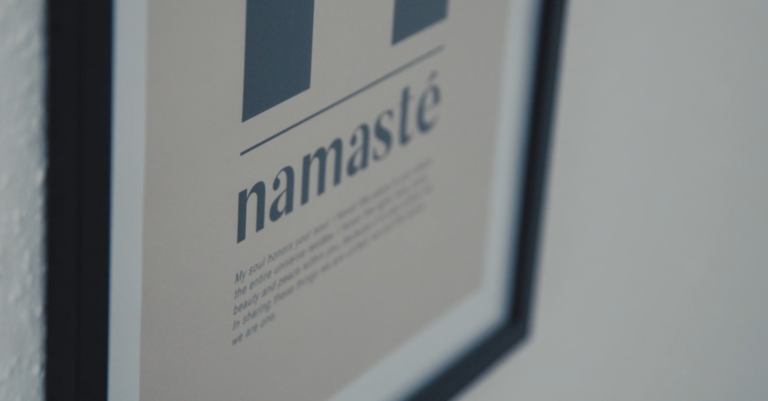Guided Buddhist meditation is a practice that has been gaining popularity in recent years. It is a form of meditation that is designed to help individuals achieve a state of mindfulness and inner peace. The practice involves following the guidance of a teacher or audio recording, which can help to keep the mind focused and centered. I very often integrate Guided Buddhist Meditation into my Yoga classes as a meditation after the class.
One of the benefits of guided Buddhist meditation is that it can be helpful for beginners who may struggle with quieting their minds during meditation. The guidance provided by a teacher or recording can help to keep the mind focused on the present moment, which can be especially helpful for those who are new to meditation. Additionally, guided meditation can be helpful for those who are looking to deepen their meditation practice, as it can provide new insights and perspectives on the practice.
Guided Buddhist meditation can be practiced in a variety of settings, including at home, in a group setting, or at a meditation center. There are also many resources available online, including guided meditation recordings and instructional videos. Whether you are new to meditation or looking to deepen your practice, guided Buddhist meditation can be a helpful tool for achieving a state of mindfulness and inner peace.
Pros ✅
✅ The cushion set includes an extra free cover
✅ Filled by 100% top-grade buckwheat hull
✅ Layer of foam offers a soft landing
Cons 🚫
🚫 The velvet cover may not be as durable as the cotton cover
🚫 The cushion may be too firm for some users
Origins of Buddhist Meditation
Buddhist meditation has a rich history that dates back to the time of the Buddha, who lived and taught in Southeast Asia about 2600 years ago. The Buddha founded an experiential path that inspired generations of practitioners to sit in mindful awareness and breathe their way to lasting peace.
The Buddha himself discovered meditation through his own personal experience. He had tried various methods of self-mortification and asceticism, but he found that these practices did not lead to true liberation from suffering. Instead, he turned to meditation as a means of understanding the nature of the mind and the causes of suffering.
Over time, the Buddha developed a system of meditation that included various techniques and practices. These practices were designed to cultivate mindfulness, concentration, and insight, and to help practitioners overcome the obstacles that prevent them from realizing their true nature.
One of the most popular forms of Buddhist meditation today is guided meditation. In guided meditation, a teacher or guide leads the practitioner through a series of steps designed to help them achieve a state of calm and clarity. Guided meditation can be practiced in a group setting or individually, and it can be tailored to the needs and abilities of each practitioner.
Guided Buddhist meditation can be a powerful tool for overcoming stress, anxiety, and other challenges in life. By learning to focus the mind and cultivate inner peace, practitioners can develop greater resilience and strength in the face of adversity. Whether you are new to meditation or an experienced practitioner, guided meditation can be a valuable addition to your spiritual practice.
Understanding Guided Buddhist Meditation

Guided Buddhist meditation is a practice that involves following a teacher’s instructions while meditating. It is a popular method of meditation that has been used for centuries in the Buddhist tradition. In this practice, a teacher guides the meditator through the process, helping them to focus their mind and achieve a state of calm and relaxation.
Guided meditation can be done in person or through audio recordings. It is an excellent way to learn how to meditate, especially for beginners who may find it difficult to focus on their own. It is also helpful for those who struggle with distracting thoughts during meditation.
During a guided meditation session, the teacher may instruct the meditator to focus on their breath, body sensations, or visualizations. The teacher may also provide guidance on how to deal with distracting thoughts that may arise during the meditation.
Guided Buddhist meditation can be used for various purposes, including stress reduction, relaxation, and spiritual growth. It is a helpful tool for those who want to develop their meditation practice and deepen their understanding of Buddhist teachings.
In addition to being a useful tool for individuals, guided meditation is also used in group settings, such as in meditation classes or retreats. It can help create a sense of community and support among meditators.
Overall, guided Buddhist meditation is an effective way to learn how to meditate and deepen one’s practice. It can be done in person or through audio recordings and can be used for various purposes, including stress reduction, relaxation, and spiritual growth.
Benefits of Guided Buddhist Meditation

As someone who has been practicing guided Buddhist meditation for some time now, I can attest to the numerous benefits it has brought to my life. Here are some of the mental and physical health benefits that I have experienced and that research has shown:
Mental Health Benefits
- Reduces stress: Guided Buddhist meditation can help reduce stress levels by promoting relaxation and calmness.
- Improves focus and concentration: By training the mind to focus on the present moment, guided Buddhist meditation can improve focus and concentration.
- Increases self-awareness: Through guided Buddhist meditation, one can become more aware of their thoughts, emotions, and reactions, which can lead to greater self-awareness and self-understanding.
- Promotes emotional well-being: Guided Buddhist meditation can help regulate emotions, reduce negative emotions such as anxiety and depression, and promote positive emotions such as happiness and compassion.
- Enhances resilience: By cultivating a sense of inner peace and calm, guided Buddhist meditation can help individuals become more resilient in the face of life’s challenges.
Physical Health Benefits
- Lowers blood pressure: Guided Buddhist meditation has been shown to lower blood pressure, which can reduce the risk of heart disease and stroke.
- Boosts immune function: By reducing stress and promoting relaxation, guided Buddhist meditation can boost immune function and improve overall health.
- Reduces chronic pain: Guided Buddhist meditation has been shown to reduce chronic pain, making it a useful tool for individuals with chronic pain conditions.
- Improves sleep quality: Guided Buddhist meditation can improve sleep quality by promoting relaxation and reducing stress and anxiety.
Overall, guided Buddhist meditation can bring numerous benefits to both mental and physical health. By incorporating it into your daily routine, you can experience greater well-being and a greater sense of inner peace and calm.
Process of Guided Buddhist Meditation

Preparation
Before starting the guided Buddhist meditation, it is essential to prepare yourself mentally and physically. Find a quiet and comfortable place where you can sit for the meditation session. Wear comfortable clothes that do not restrict your breathing or movement.
Take a few deep breaths to calm your mind and relax your body. Then, set your intention for the meditation session. You may want to focus on a particular aspect of your life or cultivate a specific quality, such as compassion or gratitude.
Meditation Session
During the guided Buddhist meditation, follow the instructions given by the teacher or the recorded audio. Usually, the meditation session begins with focusing on your breath and bringing your attention to the present moment. You may also visualize a peaceful scene or repeat a mantra to calm your mind.
As you meditate, be aware of any thoughts, feelings, or sensations that arise. Do not judge or engage with them but simply observe them and let them pass. If your mind wanders, gently bring your attention back to your breath or the object of your meditation.
Post-Meditation Practice
After the guided Buddhist meditation, take a few moments to reflect on your experience. Notice any changes in your thoughts, emotions, or physical sensations. You may also want to journal or write down your insights or observations.
Finally, carry the benefits of the meditation practice into your daily life. Cultivate mindfulness and compassion in your interactions with others. Practice gratitude and generosity. And continue to meditate regularly to deepen your understanding and connection with yourself and the world around you.
Guided Buddhist meditation is a powerful tool for cultivating inner peace, wisdom, and compassion. By following the process outlined above, you can experience the transformative benefits of this ancient practice.
3 Common Techniques in Guided Buddhist Meditation

When it comes to guided Buddhist meditation, there are several techniques that are commonly used. In this section, I will discuss three of the most popular techniques: mindfulness, concentration, and loving-kindness.
Mindfulness
Mindfulness meditation involves paying attention to the present moment without judgment. During this type of meditation, the practitioner focuses on their breath or other bodily sensations, thoughts, and emotions as they arise. The goal is to become more aware of one’s thoughts and feelings, and to develop a greater sense of clarity and equanimity.
In guided mindfulness meditation, the teacher may guide the practitioner through a body scan or visualization exercise to help them focus their attention. They may also provide prompts for reflection or contemplation to deepen the practice.
Concentration
Concentration meditation, also known as samatha meditation, involves focusing on a single object of meditation, such as the breath or a mantra. The goal is to develop one-pointed concentration and mental stability.
In guided concentration meditation, the teacher may provide guidance on how to maintain focus and overcome distractions. They may also suggest different techniques for counting breaths or repeating mantras.
Loving Kindness
Loving-kindness meditation, or metta meditation, involves cultivating feelings of goodwill and kindness towards oneself and others. The practice typically begins with generating feelings of love and kindness towards oneself, then gradually expanding to include loved ones, acquaintances, and eventually all beings.
In guided loving-kindness meditation, the teacher may provide prompts for generating feelings of love and kindness, such as visualizing a loved one or repeating phrases such as “may you be happy, may you be healthy, may you be safe, may you live with ease.”
Overall, these three techniques are commonly used in guided Buddhist meditation. By practicing mindfulness, concentration, and loving-kindness, practitioners can develop greater awareness, mental stability, and compassion.
Challenges and Solutions in Guided Buddhist Meditation
Distractions
When practicing guided Buddhist meditation, distractions can arise from external or internal sources. External distractions can include noises, smells, or other environmental factors, while internal distractions may come from thoughts, emotions, or physical sensations.
To minimize external distractions, it is recommended to find a quiet and comfortable space to meditate. If there are unavoidable noises, such as traffic or construction, try using earplugs or white noise to block them out.
Internal distractions can be more challenging to manage, but one solution is to acknowledge them without judgment and then refocus on the meditation practice. This can be done by gently bringing the attention back to the breath or the guidance provided in the meditation.
Difficulty in Focus
Another challenge in guided Buddhist meditation is difficulty in focusing. This can be due to a busy mind or lack of experience in meditation.
To overcome this challenge, it can be helpful to start with shorter meditation sessions and gradually increase the duration as focus improves. Additionally, incorporating mindfulness practices into daily life, such as paying attention to daily tasks like brushing teeth or washing dishes, can also help improve focus.
Physical Discomfort
Physical discomfort is another common challenge in guided Buddhist meditation. This can include discomfort in the back, legs, or neck, as well as restlessness or fatigue.
To address physical discomfort, it is important to find a comfortable sitting position that supports the spine and allows for relaxation. This could include sitting on a cushion or chair with the back straight and feet flat on the ground.
If discomfort persists, it may be helpful to adjust the position or take breaks during the meditation session. Additionally, incorporating gentle yoga or stretching exercises before or after meditation can help alleviate physical tension.
Overall, challenges in guided Buddhist meditation are common and can be addressed with patience and practice. By acknowledging distractions, improving focus, and addressing physical discomfort, individuals can cultivate a more effective and enjoyable meditation practice.
Guided Buddhist Meditation in Everyday Life
Through my research and personal experience, I have found that guided Buddhist meditation can be a powerful tool for cultivating mindfulness, compassion, and wisdom. By following a trained teacher’s instructions, practitioners can enter into a state of calm and focus that can help them better understand themselves and the world around them.
One of the benefits of guided meditation is that it can be tailored to the individual’s needs. Whether one is looking to reduce stress, improve concentration, or deepen their spiritual practice, there are guided meditations available that can help achieve those goals.
Another advantage of guided meditation is that it can be done anywhere and at any time. With the proliferation of meditation apps and online resources, it is easier than ever to access guided meditations from the comfort of one’s own home or office.
I think that it is important to note that guided meditation is not a panacea. Like any form of meditation, it requires consistent practice and effort to see results. Additionally, it is not a substitute for professional mental health care.
I believe that guided Buddhist meditation can be a valuable tool for anyone looking to cultivate greater awareness and compassion in their life. By following the guidance of a skilled teacher or a monk and committing to regular practice, practitioners can experience a deeper sense of peace and connection with themselves and the world around them.
FAQ
What are the 3 types of meditation in Buddhism?
The three types of meditation in Buddhism are concentration, insight, and loving-kindness meditation. Concentration meditation involves focusing on a single object, such as the breath, to develop mental stability and clarity. Insight meditation involves observing the nature of reality and gaining insight into the true nature of existence. Loving-kindness meditation involves cultivating feelings of love and compassion towards oneself and others.
What is the most powerful Buddhist meditation?
The most powerful Buddhist meditation is subjective and varies from person to person. However, some of the most commonly practiced and effective forms of meditation include mindfulness meditation, loving-kindness meditation, and Vipassana meditation.
What do Buddhist say while meditating?
Buddhists do not necessarily say anything while meditating. Instead, they focus on their breath or a specific object and try to maintain a clear and focused mind. Some practitioners may silently recite a mantra or affirmation to help them concentrate.
What are the 5 meditations of the Buddha?
The five meditations of the Buddha are the mindfulness of the body, mindfulness of feelings, mindfulness of mind, mindfulness of mental objects, and mindfulness of the nature of reality. These meditations aim to increase awareness and understanding of the self and the world around us.
Who is a well-known teacher of Buddhist meditation?
There are many well-known teachers of Buddhist meditation, including Thich Nhat Hanh, Pema Chödrön, and Sharon Salzberg. Each of these teachers has their own unique approach to meditation, but all emphasize the importance of mindfulness, compassion, and insight.
What are some recommended Buddhist meditation books?
Some recommended Buddhist meditation books include “The Miracle of Mindfulness” by Thich Nhat Hanh, “Real Happiness” by Sharon Salzberg, and “The Heart of the Buddha’s Teaching” by Thich Nhat Hanh. These books provide valuable insights and practical techniques for developing a meditation practice.
We are very happy you now know what Guided Buddhist Meditation is. We’d love to hear your thoughts and experiences. Share your insights with us in the comments below!






